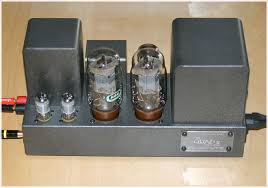In the 50s, Britain acquired quite a name in the HiFi world. The war effort had halted development and manufacturing of commercial radio and recording and by the mid 50s things were starting to look a bit more rosie, with more money around to be spent.
Before the war, Medium wave radio was the thing and record players were heavy clunky things with pickups that weighed several tons rather than several grams, records didn’t last long. Developments in stereo sound recording and reproduction had been well underway pre war, helped along by engineers such as Alan Blumleine at EMI, who had been instrumental in radar development for the RAF. Decca came up with a full range record pickup, much lighter and capable of high quality reproduction.
Crystal pickups were common place. They were cheap and allowed kids to afford their own record players (Dansett!). Three companies dominated record player manufacturing. BSR (Birmingham Sound Reproducers), Garrard and Collaro. BSR decks were simple budget machines but worked well and could be fixed with a coal chisel and some string. Garrard decks were solid, better quality and cost more. Then Collaro…. Now these decks were aimed at the high quality end of the market. Unfortunately the bloody things never worked consistently, even when brand new. Collaro was responsible for 89% of radio repairers being admitted to mental institutions as a result of fighting with these dam things.
Tape recorders were becoming popular. You could record your best tunes off Two way Family Favourites, save buying the records (although you heard the clock ticking in the background and granny doing the washing up, because you had the mic next to the radio, facing the wrong way) and you could play back your own voice. BSR again came up with a budget deck, TD1 which was used by many tape recorder manufacturers. Apart from the little round spring that used to break, they were great machines. A quick call to BSRs’ office, speak in Brummie and 3 replacement springs would be in the post. If you didn’t mind spending a months’ wages, you could buy a Truvox, Brenell or Ferrograph. These had an extra replay head, so now you could make an echo chamber, what fun was had! Collaro also made tape decks…say no more.
Post war amplifiers were becoming more sophisticated. Mullard were producing good valves to cater for this. EL84s and EL34s still are the preferred valve today in the enthusiasts’ eye. Ear, I should say. Makers such as Quad, Leak, Rogers were making first class gear. These makes command a high price today. In the late 60s and 70s transistors had replaced valves. This gave a more clinical and colder sound in my opinion.
Loudspeakers were a crucial part of your set up. They had to be efficient given that you only had 10-20 watts of power a channel to play with. Tannoy, Warfdale, Celestion and Lowther were excellent examples. With cleverly designed cabinets, every last drop of power was made use of. They sounded great. You would be amazed what you can do with just a few watts. You really don’t need buckets of power, honest.
FM radio was being broadcast around the mid 50s. You were free of interference and listening to concerts sounded like you were in the orchestra pit, right there. Leak came up with a very stable tuner. It was based on a coaxial line resonator, called a trough-line. Other tuners tended to drift and you would chase your station around the dial every half hour but these were rock solid. You had a nice green magic eye to assist in tuning in to the station. It looked impressive and was a big help if you were stone deaf. Stereo radio was introduced the early 60s. and with the addition of a decoder to your tuner or radio, you were flying. BBCs Third program started stereo programs first, followed by the Light program.
By the 70s, many of the names had given up competing with the imported Japanese equipment. The businesses were sold off and their names used to badge mass produced toot. In the 50s-60s, there were many small back street companies, employing 10-20 people producing good equipment. The designs were normally based around Mullards’ published circuits. Mullard came up with quite a few good designs to promote the use of their valves. It was a good move. I suppose it’s good testament to these companies that their products costing say £35 in the early 60s now sell for £500 plus, and that’s after giving over 40 years of service.




